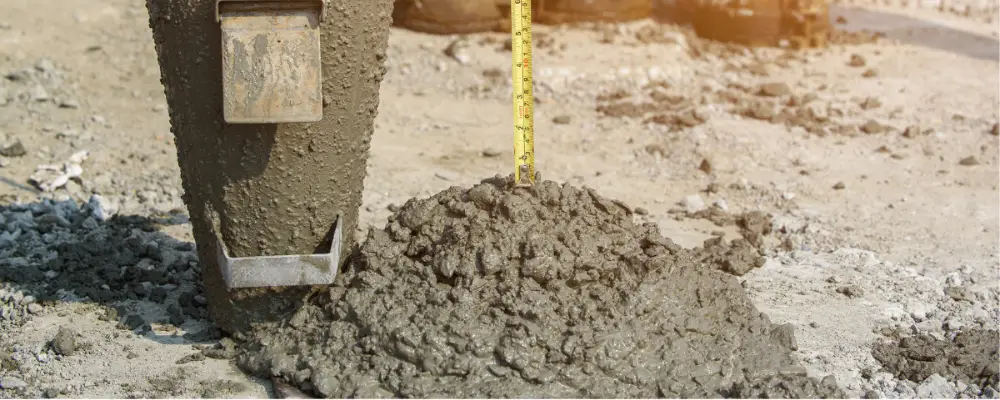While there are different types of concrete for various purposes, zero-slump concrete is often preferred among constructors. It is a highly dense and stiff mixture with less flowability. This prevents any unnecessary movements between materials, providing enough strength to the structure to withstand heavy loads. Its characteristics make zero-slump concrete stand out from other concrete types. Its uniqueness makes it an irrefutable choice in high-performance construction applications. If you still can’t figure out the role of zero-slump concrete in the construction sector, this article will answer all your questions. Who knows, it may become your preferred product in your dream projects.
What is Zero Slump Concrete?
It is a type that has a very low water-to-cement ratio, making it thick and dry in consistency. The standard slump test, which is used to measure the workability of concrete, shows little difference to no change. This height difference in the test implies the inability of the mixture to flow or spread under its weight. However, the decrease in the amount of liquid or water content does not reduce the binding and hydration properties of the cement. This type is often used in precast concrete products as they require form retention and minimal shrinkage. Some precast concrete products are concrete blocks, paving stones, and industrial flooring. The addition of chemical mixtures can increase the flowability to a certain extent, making it adaptable to handle stiff mix.
Key Features of Zero Slump Concrete
- As said above in the introduction, it is the features of zero-slump concrete that make it special from other conventional mixes. One of those special features is a low water-cement ratio, providing a non-flowing mixture. Below are some of the features that make it a perfect choice.
- Zero-slump concrete is a perfect match for load-bearing structures and heavy-duty applications. This becomes possible because of its reduced water content. The reduced water content provides a suitable situation to develop high compressive strength.
- It requires special equipment such as mechanical vibrators and structured molding techniques to handle it with ease.
- Zero-slump concrete is less susceptible to shrinkage, cracking, and other faults. Low water content makes it more durable in harsh environments. This makes it infallible even in extreme temperatures and exposure to aggressive chemicals.
- Once cured, zero-slump concrete improves durability and increases its resistance to wear and tear.
- Time consumption in terms of setting is much less compared to other concrete mixes. Its reduced water content provides a beneficial outcome in certain construction applications.
Practical Uses of Zero Slump Concrete in Construction

Wherever there is a requirement for high strength and durability in construction applications, zero-slump concrete appears to be a lifesaver. Some of the common applications where the usage of zero-slump concrete could be found are,
- Zero-slump concrete’s ability to hold form without giving rise to any weakness makes it the perfect choice for producing moulded products. The moulded products include precast concrete elements such as pipes, manholes, blocks, and panels.
- As we know now that zero-slump concrete is highly durable and has heavy load-bearing capacity, it is widely used in the construction of industrial pavements and roadways. Its tendency to withstand wear and tear makes it a preferable choice for projects where heavy loads are expected.
- It is also used in the foundation work of large construction projects that involve heavy machinery and equipment. It is possible because of its maximum strength and load-bearing capacity.
- As it is resistant to environmental conditions, zero-slump concrete is used in industrial floors and offshore platforms to resist any exposure to chemical wear, freeze-thaw cycles, and abrasion.
- It is even used in reinforced concrete structures like beams, columns, and slabs to support substantial weight.
Benefits of Using Zero Slump Concrete
While the number of advantages can be reaped from the usage of zero-slump concrete, some of the key benefits are,
- The minimal water content reduces the possibility of shrinkage by increasing the strength. This also contributes to the durability against weather, chemicals, and mechanical wear and tear.
- Low water content maintains the form of the concrete without developing cracks. This makes them suitable for long-lasting structures.
- The curing time for zero-slump concrete is much faster than that of other conventional concretes. This reduces the overall construction time, making it suitable for projects that require quick turnaround.
- Less consumption of water by zero-slump concrete is considered to be more sustainable. High durability negates the need for periodic maintenance, reducing the overall environmental impact.
- Their stiff nature makes them adaptable to fit into any mould of various shapes, making them suitable for precast concrete structures.
Limitations and Challenges with Zero Slump Concrete
While there are many advantages, zero-slump concrete has its challenges and limitations. Some of the common challenges in terms of application of zero-slump concrete are,
- In terms of handling zero-slump concrete, low workability poses a greater challenge for mixing, transporting, and placing. This requires special equipment such as mechanical vibrators, pumps, or specialised mixing trucks. This, in turn, increases the overall cost of the project.
- Zero-slump concrete requires high aggregate and additives to balance the low water content inherited with them. This again increases the cost of mixing when compared to other types.
- They cannot be used in all types of construction projects because of their dense consistency. They are suitable for precast elements, road pavements, and structural components.
- Zero-slump concrete requires huge labour, and its low workability increases the difficulty in achieving a smooth finish. This may reduce the aesthetic look of the concrete surfaces.
Testing and Monitoring Zero Slump Concrete Quality
Testing any type of concrete is crucial to assess its desired performance standards. While slump tests are the usual assessment method, when it comes to assessing the workability of zero-slump concrete, it is not effective. Specific tests and monitoring techniques employed are
Compression Strength Testing: Cast cubes or cylinders are cured and subjected to load to test the compressive strength of the concrete. This determines whether concrete has achieved the desired strength or not.
Durability Testing: This method is used to test the long-term performance of the concrete and assess its resistance capacity against freeze-thaw cycles, chemical attacks, and abrasion.
Water-to-cement ratio monitoring: As we all know, the ratio of water-to-cement is very important in zero-slump concrete to ensure proper curing and hydration; it is also assessed.
Conclusion
Zero-slump concrete has a distinct set of characteristics owing to its low water-to-cement ratio and stiff consistency. It is in high demand for structural elements that require a high bearing capacity, such as heavy-duty pavements, precast elements, and other substantial structural components due to its low brittleness and cracking, as well as high compressive strength and shrinkage properties. However, deciding on zero-slump concrete does come with limitations considering it has low workability which requires specific equipment to mix it or even place it. In today’s world, zero-slump concrete is a valuable asset; however, it is neither cost-effective nor effective in all kinds of construction work. As such, this makes it a daunting material to work with amid such high standards concerning strength, durability, and form retention. Keeping that in mind, zero-slump concrete must be monitored consistently and correctly tested to maintain its quality.

